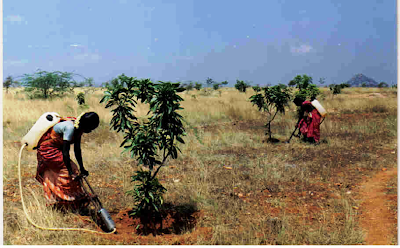 |
| SEVAI: injecting water to trees in barren land-afforestation efforts |
SEVAI injects water to the roots of
trees in barren lands of Kulitalai Taluk of Karur District to withstand the
drought. It applies the conjunctive use of water for trees watering. SEVAI
(www.sevaingo.in) a Trichy based NGO devotes considerable time and energy to
planting trees even in barren lands as trees are more than a token symbol of
environmentalism; they are in fact key components to global ecosystems. SEVAI encourages people
of Therkkuvasal of Pappakkapatty Panchayat in Karur District to plant their
barren land with various local trees. Community members are
enthusiastically responding the reforestation programme. They work very hard to
clear stones in the land, plant hardwood trees, build fences with stones to
protect trees from livestock.SEVAI does not only encourage people to plant
trees but also prepares the local people to make sure that they will be
responsible in planting and preserving the trees planted. Trees for the Future
is dedicated to planting trees with rural, to restore their environment, grow
more food, and build a sustainable future. Trees have always been a key symbol of the environmental movement. Trees
act as natural filters of our air. Through the process of photosynthesis trees
absorb carbon dioxide from the atmosphere and store the carbon in their trunk,
branches, leaves, roots, soil and foliage, while releasing oxygen back into the
atmosphere. A fundamental requirement for all animals is a supply of oxygen. Through
the process of photosynthesis, trees and other vegetation supply us with this
vital gas. One mature tree produces enough oxygen for 10 people to inhale in a year.
The removal of trees from the landscape can have disastrous repercussions in
terms of making such areas more prone to landslide. Erosion control most
frequently involves the planting of tree, shrub or grass species. The roots of
the vegetation bind the soil and prevent erosion. The instance of flash
flooding has been shown to be reduced by the presence of forests. Also in areas
prone to drought the addition of trees to the landscape can aid in the
conservation of precious water resources. Trees slow down water runoff after
periods of heavy rainfalls and help to recharge underground water-holding
aquifers. -Govin










